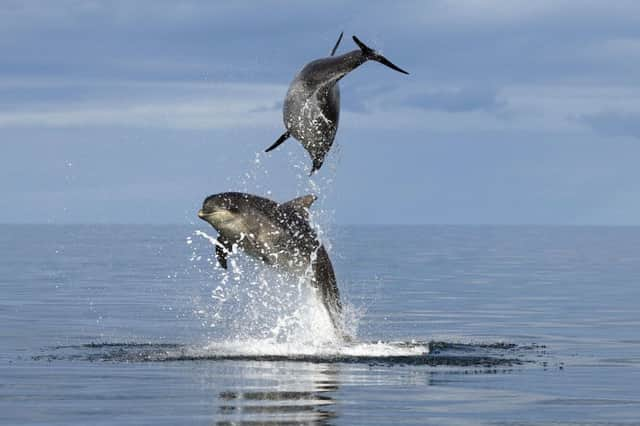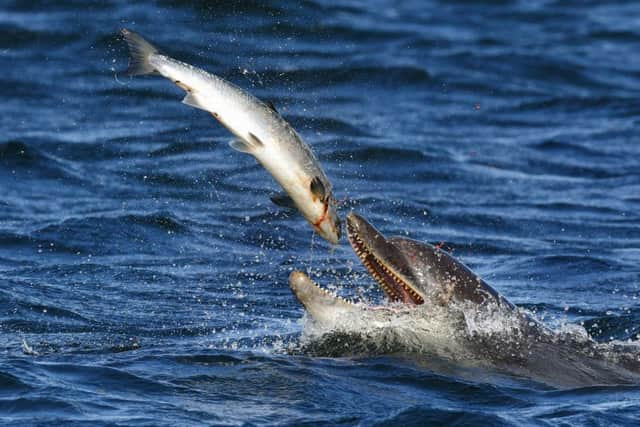In pictures: The graceful dolphins of Moray Firth


Charlie Phillips, field officer with Whale and Dolphin Conservation (WDC) and a professional wildlife photographer, introduces five of his favourite images from his new photographic study of the dolphins of the Moray Firth, animals he has studied for many years. The resident pod of 190 creatures is one of only two established pods that stay in a specific area (the other is off the coast of Wales). They do so becasue there is no need to move – food is plentiful and they are not threatened too much by human activity (the area is a special area of conservation).
1. This is a nice blue sea and blue sky close up shot of two young bottlenose dolphins (called Castillo and Mini Fin) trying to outjump each other out in open water in the Moray Firth. Taken from the Aberdeen University Lighthouse Field Station’s research boat Rona, I just happened to be in the right place at the right time with my very fast camera. We researchers were in awe, not just of the acrobatic ability of these young dolphins (both around seven years old), but also of the close proximity of the dolphins to us onboard the boat – they definitely knew that we were watching them.
Advertisement
Hide AdAdvertisement
Hide Ad2. I like this photo and included it in the book as it shows, un-sanitised and in the raw, the bottlenose dolphin for what it really is – a fantastic, highly skilled top end apex predator that has to kill to survive. In this case we have a local resident female dolphin called Zephyr with an Atlantic salmon as her prey, which is one of the dolphins’ favourite spring/summer food species. A typical adult dolphin in this population will eat at least five of these big fish before they start to feel full, but they have to eat as much as they can because, in the wild, you never know where your next meal is coming from – or when.


3. The dolphin bursting through the waves and blue sea in this photo, which is also the front cover image of the hardback book, is a young male called Charlie – named after me by Aberdeen University researchers! He’s a great favourite around the Inverness and Chanonry Point areas. This photo was taken from land at Chanonry Point and was caught at the very last split second (as a lot of dolphin photos are) as the dolphin half breached through the waves. Charlie’s mother is a lovely female called Kesslet, named after the village of North Kessock, near Inverness and is one of the six dolphins that the public can adopt through the Whale and Dolphin Conservation Adopt a Dolphin programme.
4. This is one of my all-time favourite dynamic photos taken from the beach at Chanonry Point, Fortrose on the Black Isle. It shows two adult male dolphins (called Prism and Scoopy) simply having fun – no animosity or bad feeling, just sheer fun. Energetic behaviour like this is what I love to study as all this activity costs the dolphins calories that have to be replaced. This body language, as we would describe it, must be important to the dolphin socially, to expend the colossal amount of energy that it takes to hurl a dolphin weighing 500kg maybe six metres into the air.
5. The dolphin surfacing to breathe in the idyllic tranquil blue sea is called Puddles. She’s the young daughter of Muddy and is rising up through the water column beside the research boat that I was working on. It was a day of exceptional sea clarity and visibility in the Moray Firth and this frame is only one of a rapid series of shots (12 frames every second) taken as I was able to track the dolphin underwater coming up for air. This image won me an international photography award and has a special place in my heart.
• On a Rising Tide by Charlie Phillips is published by Ness Publishing at £19.50, out now. For more about the work of Whale and Dolphin Conservation, including how to adopt a dolphin, see whales.org